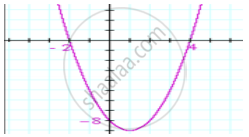Advertisements
Advertisements
Question
Divide. Write the quotient and the remainder.
(6x5 − 4x4 + 8x3 + 2x2) ÷ 2x2
Solution
(6x5 − 4x4 + 8x3 + 2x2) ÷ 2x2
= \[\frac{6 x^5 - 4 x^4 + 8 x^3 + 2 x^2}{2 x^2}\]
= \[\frac{2 x^2 \left( 3 x^3 - 2 x^2 + 4x + 1 \right)}{2 x^2}\]
= \[3 x^3 - 2 x^2 + 4x + 1\]
So, quotient = \[3 x^3 - 2 x^2 + 4x + 1\] and remainder = 0
RELATED QUESTIONS
Classify the following polynomials as polynomials in one-variable, two variables etc:
`x^2-xy+7y^2`
Define degree of a polynomial.
The graph of the polynomial f(x) = ax2 + bx + c is as shown in Fig. 2.20. Write the value of b2 − 4ac and the number of real zeros of f(x).

For what value of k, −4 is a zero of the polynomial x2 − x − (2k + 2)?
For what value of k, is 3 a zero of the polynomial 2x2 + x + k?
If f(x) is a polynomial such that f(a) f(b) < 0, then what is the number of zeros lying between a and b?
If one root of the polynomial f(x) = 5x2 + 13x + k is reciprocal of the other, then the value of k is
An asana is a body posture, originally and still a general term for a sitting meditation pose, and later extended in hatha yoga and modern yoga as exercise, to any type of pose or position, adding reclining, standing, inverted, twisting, and balancing poses. In the figure, one can observe that poses can be related to representation of quadratic polynomial.


In the graph, how many zeroes are there for the polynomial?

The degree of the sum of two polynomials each of degree 5 is always 5.
Classify the following as a constant, linear, quadratic and cubic polynomials:
y3 – y
